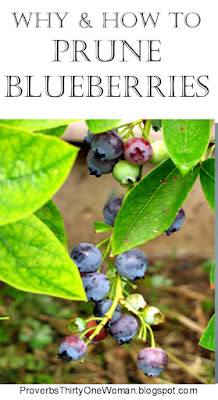"He cuts off every branch in me that bears no fruit, while every branch that does bear fruit he prunes so that it will be even more fruitful."
John 15:2
When we purchased our mountaintop homestead about a year and a half ago, we were blessed to discover four blueberry bushes. Not all of them are large, but they are an excellent addition to the potted blueberry plants we brought with us from suburbia. (Because if there's one thing I've learned about blueberries, it's this: I can't ever seem to grow enough of them for my family!) Last year, for the first time ever, I even had enough blueberries to preserve a few for winter...Happy dance!
Still, the blueberry bushes that came with our property hadn't been pruned in years, so last weekend, I gave them a good trimming. Why prune blueberry bushes? Well, pruning will eventually make your harvest bigger - and the individual berries will grow bigger, too. Pruning also helps keep the plant healthy, warding off disease. Plus, a well pruned plant is also considerably easier to harvest from.
 |
| My blueberry bushes were a tangled mess. Pruning was in order! |
When to Prune Blueberry Bushes
The best time to prune is when the bushes begin forming buds. For me, that's right now. If your winters aren't as mild as ours, you probably won't see buds until early spring.
How to Prune Blueberry Bushes, Step by Step
1. Begin by removing all dead branches. This encourages new growth and keeps the plant productive and healthy.
2. Now remove any branches that cross each other, especially if they are touching. If you let crossing branches stay on the plant, it becomes harder to find fruit and may prevent (and will always slow) ripening of the berries.
3. Next, remove branches that point toward the center of the bush. Such branches reduce air circulation, which can cause disease. In addition, a more open bush gives more light to the fruit, which helps berries ripen.
 |
| The large buds are future blueberries. The small stubs are future leaves. |
What to Do with Blueberry Prunings
You may wish to burn or chip your blueberry prunings. Wood ash is a great addition to organic gardening soil, and chips are a wonderful mulch. But you might also want to keep at least some blueberry branches for homestead rabbits or pets like hamsters or guinea pigs. These creatures have teeth that continue to grow throughout their lifetime; chewing branches is absolutely necessary for them to keep in tip-top shape - and blueberry branches are safe chewing material.
 |
| I'm saving these prunings for our rabbits. |
Fertilizing Blueberry Plants
After you're done pruning, take a few minutes to fertilize the plants. Blueberries love acidic soil, and very few of us have enough acid in our gardens to make them productive and happy. (Not sure what the acidity is in your soil? Use a simple home test kit; I use this one. For blueberries, the soil pH should be at least 5.5.) Coffee and tea grounds can help add acid to the soil. Even better is an inch or two of Sphagnum peat. You may also use commercial fertilizer that's made especially for blueberries and rhododendrons. I use Down to Earth's all natural acid fertilizer. Just sprinkle whatever fertilizer you're using around the base of the plant, then water it in well. (Don't dig it into the soil, or you risk damaging the plant's root system.) Having trouble getting your soil acidic enough? Plant blueberry bushes in very large pots, instead. We did this successfully for many years.
Related Posts
* How to Grow Honeyberries
* Mini Blueberry Pies











No comments